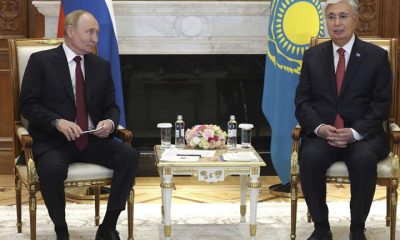Trending
Fact check: AI images instead of real Beirut airport attack
The conflict between Israel and Hezbollah is also a battle of images — and not everything is real. Like two viral images of an alleged Israeli attack on Beirut airport in Lebanon.
What is real in the Middle East conflict and what is not? That’s been a question ever since the escalation of violence since Hamas’ terrorist attack on Israel on October 7, 2023. Much of what is shared, liked and commented on online is neither authentic nor up to date. And the latest fighting between Hezbollah in Lebanon and Israel has again seen a flood of misleading, manipulated or fake content on social media networks. Here are two recent examples:
Claim: Two pictures of an alleged attack on the airport in Beirut are currently going viral: “A photo for the history books. A plane from the airline MEA lands at Beirut International Airport while Israel fires on the airport,” writes a user on X, sharing a picture that is supposed to show the airport. Another X user shares a second picture and claims that this was “an airliner full of passengers at Beirut International Airport.”
DW Fact check: Fake
Both images are not real but were generated with the help of artificial intelligence. The picture above is supposed to show an airplane approaching to land. Buildings can be seen in the foreground. One of them has illuminated windows. Some of the frames are straight, some are slightly slanted and arranged in a strangely irregular way — something we often encounter in AI-generated images of buildings. In addition, when zoomed in, a kind of blurred bar appears above parts of the aircraft windows and the nose of the aircraft is noticeably short.

The nose of the aircraft is shorter than on the aircraft types flown by MEA, the paintwork of the tail is different and the windows seem to be missing in the front part. The building also has image errors.
© X
We have compared this with images of aircrafts from the airline MEA. According to the company, MEA flies the Airbus models A320 200, A330 200 and A321 NEO. All models have a longer aircraft nose than the one in the AI-generated image. The airline logo on the tail in the image posted on X differs from the actual logo of the airline. There are also anomalies with the aircraft lights. The light shown on top of the fuselage does not comply with international standards. Collision warning lights at the top and bottom of the fuselage are always red, not white as in the picture. This can be seen in the Aviators Guide.
AI detector spots “significant evidence of tampering”
The second picture shows an aircraft on the ground and an airport building in the background. Similar issues can be detected: curved and crooked rows of windows on the building at the back left, landing gear tires on the aircraft that are too far apart, or strangely illuminated doors on the aircraft fuselage. We also checked both images with the AI detection tool from Truemedia.org. In both cases, the software concluded that there was “substantial evidence of manipulation.”

This image also does not show a real attack on Beirut airport. It’s AI-generated, showing an aircraft and a burning building
© X
Despite these issues, a reverse image search shows that the images were shared on numerous platforms such as Threads, Reddit, Telegram, Instagram, and X.
In addition, several Arabic, Russian and Turkish media outlets that reported on the alleged attack also used these AI-generated images. Even well-known media such as CNN Turk or MSN Turkish fell for the fakes and published them.
However, the fact that the two images are not real but AI-generated does not mean that there have not been actual attacks by the Israeli armed forces on targets such as Beirut airport. At the beginning of October, for example, images in media reports showed several actual explosions near the airport.
Nicolas Hammerschlag Vicuna contributed to this article
Author: Joscha Weber
Trending
The man who tackled a gunman to the floor and saved people from getting sh0t at Bondi Beach in Australia has been identified as Ahmed al Ahmed.

The man who tackled a gunman to the floor and saved people from getting sh0t at Bondi Beach in Australia has been identified as Ahmed al Ahmed.
He was shot during the incident and is currently recuperating in a hospital.
Meanwhile the two gunmen who k!lled over 9 people during the attack were neutralised.
NB: This page does not support violence and this is just a news report.
https://www.instagram.com/reel/DSQXFGajEFV/?igsh=M295eGdiNGVtbHBn
🎥 @7newsaustralia
Trending
Female Student Missing For 8 Days Found Chilling At Boyfriend’s House

A fresh controversy erupted online after a female student, missing for eight days, was found at her boyfriend’s house.
Details of the incident were shared by a classmate of the lady, identified as @folaaaa on X (formerly Twitter).
According to @folaaaa, her classmate’s parents are of age, and the father disclosed that he is currently 70 years old.
Prior to her being found, her last WhatsApp activity was on Monday, December 8, 2025.
Read Tweet Below…..
My coursemate was reported missing by her parents yesterday. They said they could not reach her for like 8 days. We did our research she was last seen online on Monday. They sha did perfect investigation with the oga olopa and they found out she was with her man”.
Meanwhile, the tweet which has garned over 400,000 views has been flooded with reactions from X users.
Dam Dam stated, “Dem suppose arrest Her and her man. Make dem sleep inside cell for a week. Imagine giving your parents so much headache and eventually you are with a man,at least call them and let them know you are safe wherever you are”.
PP the art, “The number of people that had shared and reshared “missing girl” on my WhatsApp cl was crazy. my friend was telling me this just now and i was so shocked”.
Jimmy, “Same thing happened in my department while i was in year 1,fliers were made they even interrogated her male friends.these went on for the whole of the semester only to find out she reads the class group messages and sees the missing fliers. She then later said she’s with her man”.
Bhetty, “She went to see a man and she didn’t take her parents’ call?Make she sleep cell for 3 days”.
See below…..

Trending
“It took me getting married and giving birth to realise marriage benefits men more” — Woman shares emotional thoughts

A woman has stirred serious conversations online after opening up about how marriage and motherhood changed her perspective on life.
In a heartfelt reflection, she said it was only after getting married and giving birth that she began questioning who marriage truly benefits.
According to her, women often carry the heavier load — emotionally, physically, and mentally.
She explained that marriage can make women feel like tools, responsible for cooking, cleaning, caring for the home, and even contributing financially, while still bearing the full weight of pregnancy, childbirth, and childcare.
She questioned why something described as a “blessing” should come with so much pain, stress, sleepless nights, and emotional strain for women.
In her words, childbirth comes with intense pain, followed by years of responsibility that largely fall on the woman, while many men continue life almost unchanged.
She admitted she never strongly pushed for marriage herself and only went along with it after family pressure. It was the lived experience — not theory — that opened her eyes.
While she made it clear that she loves her son deeply and finds joy in him, she said motherhood also forced her to confront uncomfortable truths about expectations placed on women.
📹: TT/mummychika1
https://www.instagram.com/reel/DSP0XSnjAvd/?igsh=MTd3ZzdlbWI0dHV1Nw==
-
Business1 year ago
US court acquits Air Peace boss, slams Mayfield $4000 fine
-

 Trending1 year ago
Trending1 year agoNYA demands release of ‘abducted’ Imo chairman, preaches good governance
-

 Politics1 year ago
Politics1 year agoMexico’s new president causes concern just weeks before the US elections
-

 Politics1 year ago
Politics1 year agoPutin invites 20 world leaders
-

 Politics1 year ago
Politics1 year agoRussia bans imports of agro-products from Kazakhstan after refusal to join BRICS
-
Entertainment1 year ago
Bobrisky falls ill in police custody, rushed to hospital
-
Entertainment1 year ago
Bobrisky transferred from Immigration to FCID, spends night behind bars
-
Education1 year ago
GOVERNOR FUBARA APPOINTS COUNCIL MEMBERS FOR KEN SARO-WIWA POLYTECHNIC BORI













